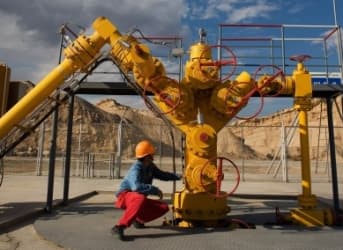Much attention has been given to recent agreements by Russia to supply China with roughly 30 billion cubic meters (bcm) of natural gas a year. According to Nomura Holdings, the estimated $284 billion deal, along with the $400 billion gas agreement signed in May to supply 38 bcm of natural gas annually for thirty years, could account for roughly 19 percent of China’s total gas consumption in 2020.
These deals are significant because, Russia, the world’s largest natural gas exporter, has a pipeline infrastructure that flows almost entirely to Europe, with the exception of a small volume that goes to Armenia, in Eurasia.

So where else is China forecasted to source its natural gas from?
Turkmenistan
China has imported gas from neighboring Turkmenistan since 2009. Today, Turkmenistan supplies almost half of China’s gas imports. Behind Russia, Iran, and Qatar, Turkmenistan holds the fourth largest reserves of natural gas. Nearly all gas exports to China come from the Samantepe gas field.
Related: China Strengthening Claim To South China Sea Oil And Gas
In an effort to improve its energy security, China has continually committed to receive larger amounts of gas from state-owned Turkmengaz. With an initial pact in 2007 to import 30 bcm per year of natural gas by 2020, China and Turkmenistan recently agreed to increase and accelerate imports to 65 bcm/year by 2016.
The speed and scale of pipeline infrastructure from Turkmenistan to China has been impressive, but there still is a long way to go to reach the goal of 65 bcm per year. Through the Central Asia-China gas pipeline network, China imported 24.4 bcm of gas from Turkmenistan in 2013, an increase of 22 percent from 2012.

Source: Kazkhbar
For Turkmenistan, China’s growing appetite for natural gas cannot come soon enough. Over the past few years, Russia and Iran have imported a combined 15-20 bcm annually from Turkmenistan and both recently signaled plans to exit or annul contracts with Turkmengaz, the national gas company of Turkmenistan.
Qatar
In 2013, Qatar supplied China with roughly 18 percent of China’s gas imports. Qatar has the largest LNG capacity in the world and has aggressively marketed its gas across the globe, identifying Asia Pacific as the primary growth market. As new LNG suppliers attempt to gain market share, especially Australia and the United States, expect Qatar to stay on the offensive.
Related: Russia-China Deal Could Kill U.S. LNG Exports
Chinese Production
Despite holding some of the largest reserves of shale gas, China’s natural gas production has been a disappointment, falling well short of government predictions. While backed by large investments and government support, natural gas production has grown slower than the economy for the last three years. Both Sinopec and PetroChina have failed to announce any large fields despite extensive drilling efforts.

Because of the recent shortcomings of shale gas production, China has taken a bigger bet on another form of unconventional gas, coal bed methane (CBM). With just 13 percent of the world’s coal reserves, but nearly 50 percent of the world’s coal production, many Chinese coal mine operators have opposed nearby coal bed methane production. They fear that pumping sand and chemicals into wells to release gas might have an unintended consequence of driving gas into their mines.
China’s CBM ambitions are clearly laid out in its 12th Five Year Plan (FYP), which outlined China’s plan to increase CBM production to 30 bcm by 2015. China’s goal is to have CBM supply 7.5 percent of the country’s energy mix by 2015, up from 4.5 percent today.
Diverse Supply
Wherever China’s natural gas comes from in the future, the government wants to have a multitude of supply options. Europe’s vulnerability from an over reliance on Russian gas has led to China placing a premium on a diversified supply of natural gas.
By Chris Pedersen for Oilprice.com
More Top Reads From Oilprice.com:
- China And US Agree Ambitious New Emissions Deal
- Russia In Weak Position For New Gas Deal With China
- China’s Emissions Could Negate Global Efforts Against Climate Change


















